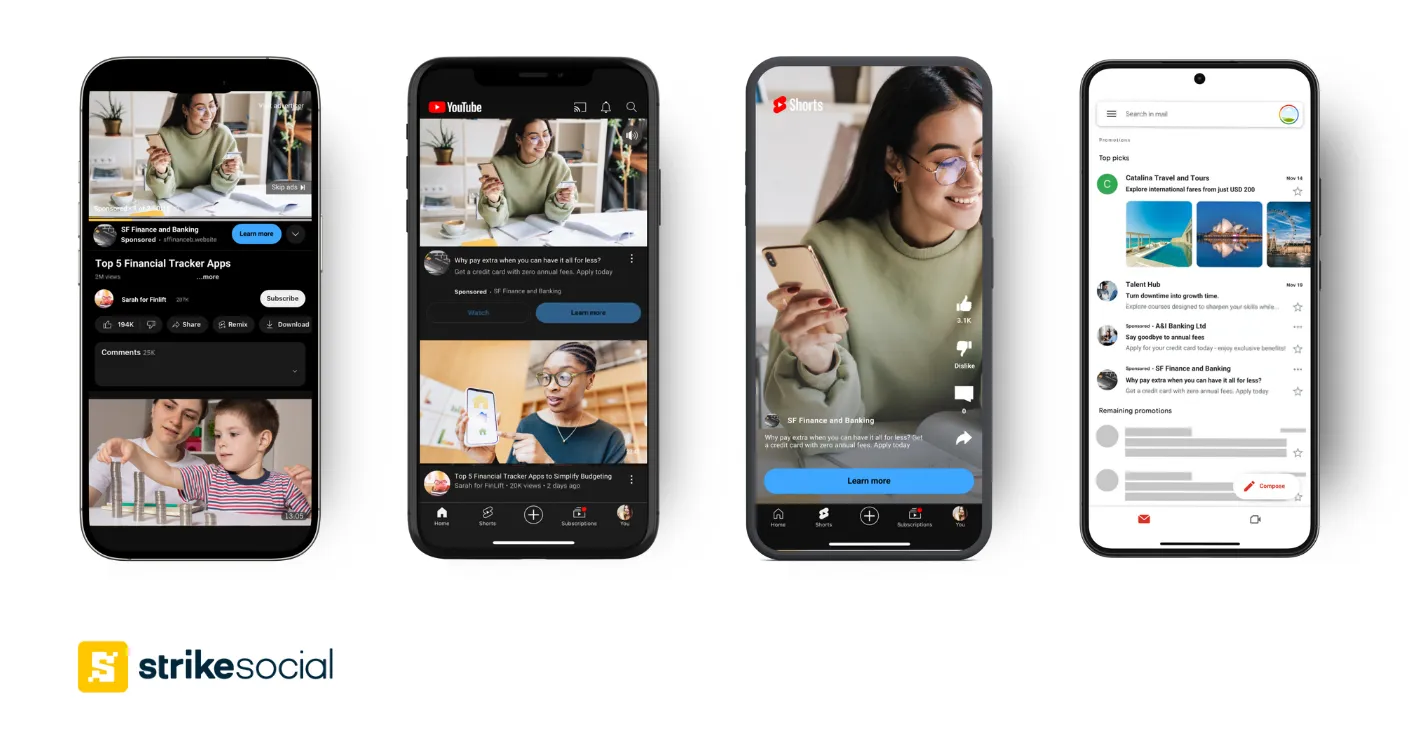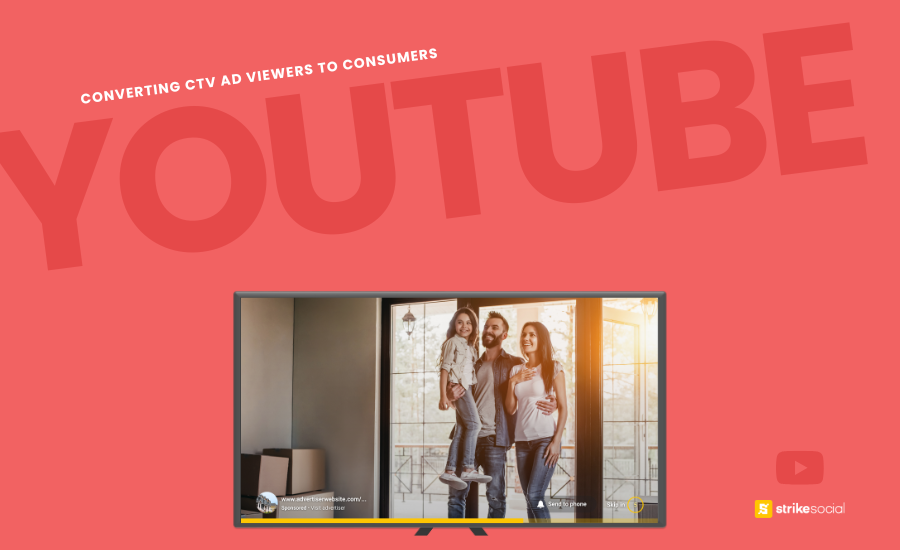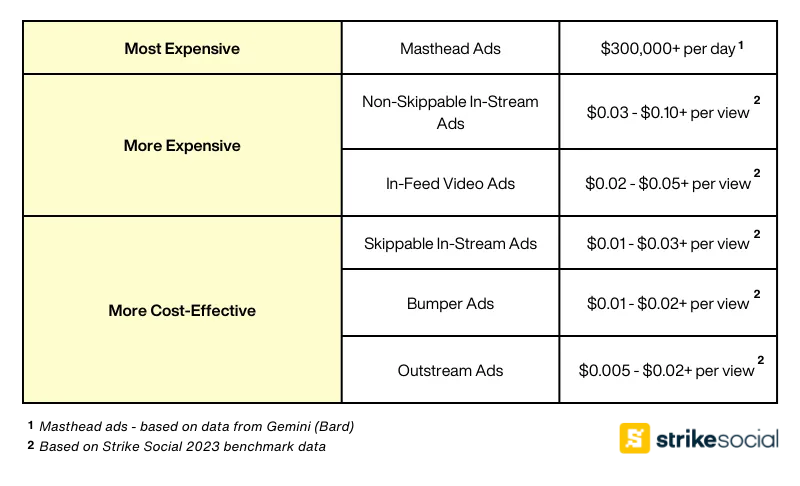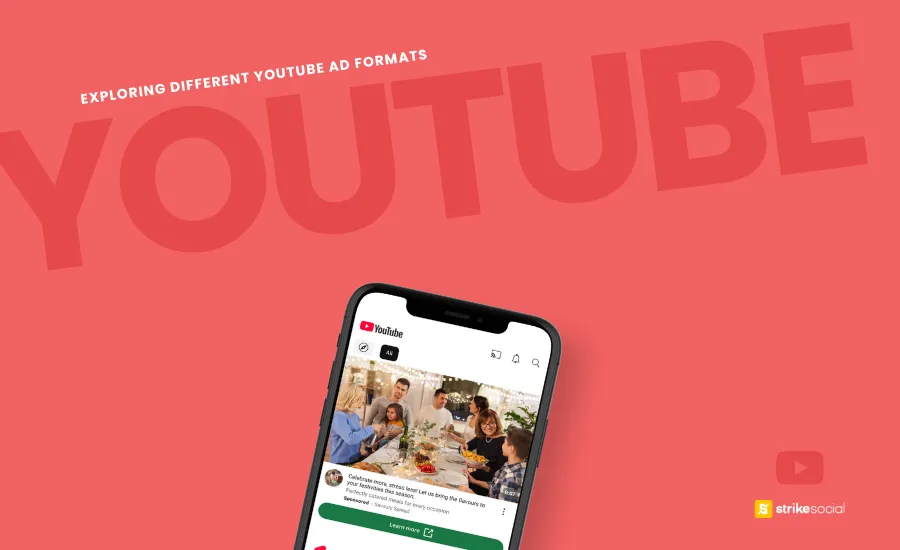Strike Overview
- Crafting a successful video ad campaign hinges on selecting the optimal YouTube ad format to engage your audience effectively.
- Having familiarized yourself with the fundamental terms of YouTube advertising, it’s time for the next step: understanding the different ad formats on YouTube.
- Despite constituting just 10.25% of Google’s overall advertising revenue, YouTube offers countless opportunities to reach your target audience.
Jump to Section
Maximize Your Reach by Exploring The Different Ad Formats on YouTube
If you’ve spent time on YouTube, you’ve encountered ads that pop up on your screen before the video starts or during the video you are watching. These ads aren’t random; they’re strategically placed to capture attention. And the good news is, you can utilize them too.
With a range of ad formats available to media buyers, you can expand your reach and tap into YouTube’s massive audience base. Join us as we explore the exciting possibilities of these YouTube advertising formats in this blog.
What Are The Different YouTube Ad Formats Available?
YouTube offers a variety of ad formats to cater to different viewing experiences, providing advertisers with a range of options to showcase their video ads. Let’s explore each available YouTube advertising format:
In-stream Ads
In-stream ads are video advertisements that appear before, during, or after a YouTube video. They come in both skippable and non-skippable formats, offering advertisers a cost-effective way to reach a broad audience. However, skippable ads allow viewers to skip after a few seconds, presenting a potential challenge for advertisers.
In-feed Ads
In-feed video ads seamlessly integrate into users’ YouTube feeds alongside organic content. These ads are highly targeted and blend naturally with the user experience, making them ideal for product consideration and retargeting campaigns.
Shorts Ads
Shorts ads are concise video or image ads that appear between Shorts in the YouTube Shorts feed. With a maximum duration of 60 seconds, these ads are strategically positioned within the Shorts feed, allowing advertisers to engage viewers with short, impactful content.
Outstream Ads
Outstream ads extend beyond the YouTube platform to Google Video Partners, allowing advertisers to reach audiences outside of YouTube. Despite being off-platform, these ads enable advertisers to connect with relevant audiences effectively.

Further Reading

Reach Household Audiences with YouTube Connected TV Ads
Uncover the potential of YouTube CTV ads to engage audiences and build brand awareness. Explore effective ways to convert viewers into leads and drive customer growth.
The Complete Breakdown of YouTube’s Video Ad Formats
Exploring the video ad formats available on YouTube is essential for understanding how your audience positions and views your ads. We will closely examine how the platform integrates them and analyze their integration.
In-stream
In-stream ads are inserted within other YouTube videos and can appear before (pre-roll), during (mid-roll), or after (post-roll) the main content. These ads may be skippable or non-skippable, depending on their length.
Skippable In-Stream Ads: Viewers can skip these ads after a few seconds.

Non-Skippable In-Stream Ads: Viewers must watch ads fully before proceeding to YouTube videos.

In-feed
These ads seamlessly integrate within the organic content in the YouTube feed, resembling organic videos with an “Ad” label. They offer high targeting precision and blend well with the user experience.
Another form of YouTube in-feed ads are the Masthead ads. These premium display ads appear at the top of the YouTube homepage for a set duration (only available through reservation via a Google sales representative).
YouTube Shorts
Short video ads, limited to 60 seconds, are displayed while scrolling within the YouTube Shorts feed.
Outstream
Video ads are displayed outside of YouTube on websites and apps partnered with Google’s video network and are available in various formats like banners or expandable video players.
Other YouTube advertising formats
Watch Feed Ads: Ads appearing in the feed of recommended videos, enhancing visibility and engagement.
Back-to-Back Ads (Ad pods): Two consecutive video ads played during longer videos to reduce interruptions for viewers, ensuring a smoother viewing experience.
How Do I Choose The Best YouTube Ad Format For My Campaign Goals?
Selecting the most suitable YouTube ad format requires alignment with your campaign objectives and target audience.
For instance, integrating ads within searches and utilizing Google Video Partners can reach individuals outside the traditional YouTube user base but share interests with your target audience. Conversely, advertising directly on YouTube allows for precise targeting of users actively seeking relevant content.
Consider developing a comprehensive framework that evaluates these factors to facilitate decision-making. By carefully assessing your campaign objectives and understanding the distinctive characteristics of each ad format, you can make strategic choices to optimize your campaign’s performance.
Here’s a table summarizing the key characteristics and ideal uses for each YouTube ad format:
| Campaign Objective | Ideal YouTube Ad Formats | Advantages | Target Audience |
|---|---|---|---|
| Sales | In-stream (non-skippable) In-feed video ads App promotion ads (if applicable) | High engagement potential Drives conversions Versatile for showcasing products | Purchase-minded viewers |
| Leads | In-stream ads (clear CTAs) In-feed video ads Shorts in-feed ads (mobile lead gen) | Effective for capturing contact information Generates qualified leads | Action-oriented viewers |
| Website Traffic | In-stream ads (non-skippable) In-feed video ads Outstream ads (reach beyond YouTube) | Drives website visits Scales well for broad reach | Audience interested in the advertised category |
| App Promotion | In-stream ads (Download CTA) In-feed video ads App promotion ads | Directly promotes app downloads Integrates seamlessly with app stores | Mobile app users and potential users |
| Awareness & Consideration | In-stream ads (skippable & non-skippable) In-feed video ads Shorts in-feed ads (mobile brand awareness) Masthead ad (high visibility) * not available for auction | Builds brand recognition Creates lasting impressions Reaches a broad audience | Broad audience, potential customers |
| Store Visits & Promotions | In-feed video ads Outstream ads (mobile reach) | Drives foot traffic to physical stores Promotes special offers and sales | Local customers interested in the advertised products/services |
YouTube Ad Questions from Media Buyers
Can I have multiple YouTube ad formats in one campaign?
- Yes, you can have multiple ad formats in one campaign to diversify your reach and engage with different audience segments.
- For example, Video View campaigns (VVCs) allow your ads to be placed across various formats like Skippable In-Stream, In-Feed, or Shorts.
Are bumper ads more effective than longer video ads?
- The effectiveness of an ad depends on various factors, including the message, creativity, and target audience.
- Bumper ads, for instance, excel in building brand awareness due to their short length and lack of explicit call to action. On the other hand, longer video ads like non-skippable in-stream formats can be more effective for product consideration. These formats allow for storytelling and can prompt viewers to take action, such as clicking on a link or registering on a website.
Are there some YouTube ad formats that typically cost more than others?
Absolutely! YouTube ad formats vary in cost, and some tend to be pricier than others. Here’s a general cost comparison based on industry reports and trends:

- Important Note: The actual CPV for your campaign can be higher or lower depending on factors like targeting, industry, competition, and even the time of year.
How do YouTube ads compare to other advertising platforms?
- Advertising on YouTube already presents an opportunity to reach a broad audience.
- One advantage of advertising exclusively on YouTube is the transparency regarding the channels and videos where your ads appear, unlike expanding to Google Video Partners and the Search network, where it may be unclear which websites and search results feature your video ads.
What YouTube Ads Format Best Suits Your Campaign Goals?
As you progress in launching your YouTube ad campaigns, the process reveals itself to be more intricate than anticipated. With each step, you uncover many possibilities and encounter unexpected limitations. That’s why you have this trusted guide — a resource to turn to whenever you feel overwhelmed or uncertain about navigating through YouTube advertising.
Be sure to bookmark this page for future reference, as we’ll continue to update it with any new developments or insights that YouTube unveils. Keep your eyes peeled and hop on to our next YouTube blog to keep you informed.








